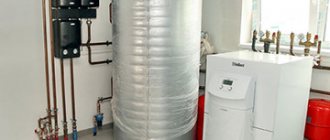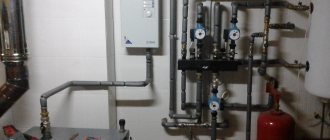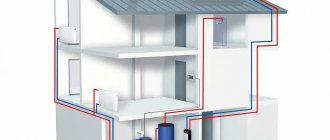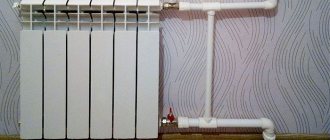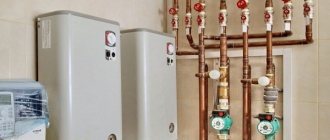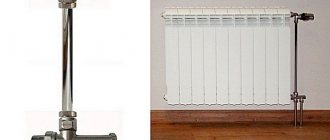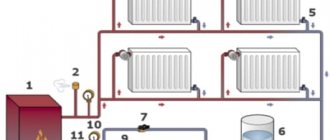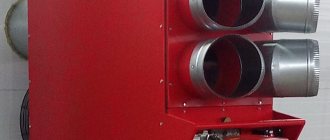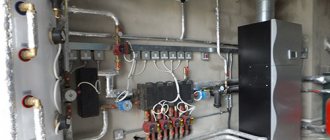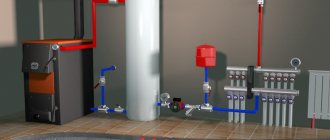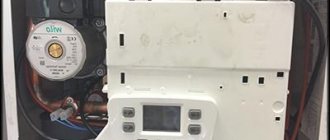When installing a heating system, various devices are used that serve as intermediaries in heat exchange with rooms. These devices have preset parameters that must comply with certain rules:
- Have a reasonable price and low material consumption.
- The heating device should be small in size and fit organically into the interior.
- The device must have sufficient resistance to mechanical damage.
- The temperature of the outer part of the heater should not be very high.
- Cleaning the heater should be easy
- Heat transfer should be as high as possible. In addition, it is necessary to be able to control the level of heat supply.
Heating appliances. Classification.
When classifying heating devices, the following parameters are distinguished:
- Thermal inertia indicator (large and small)
- What material was used to produce the device (metallic, non-metallic, combined)
- How is heat transfer carried out (convective, convective-radiative, radiation)
Radiation heating devices:
- Ceiling heaters
- Cast iron radiators consisting of several sections
- Tubular type heaters
Convector-radiation heating devices:
- Floor heating panels
- Radiators consisting of sections and panels
- Smooth tube heaters
Convective heating devices:
- Panel heaters
- Finned tubes
- Plate convectors
- Tubular convectors
There are many types of heating devices. But we will pay attention to the most common ones:
How to choose
When installing a water-heated floor under a laminate, you should take care of additional heating of living spaces with radiators. When choosing batteries for a country house, the following factors are taken into account:
- boiler power;
- type of fuel used;
- level of automation of installed equipment;
- radiator material;
- overall dimensions of the device;
- price.
A high-quality battery must have high durability, resistance to corrosion and water hammer, and withstand high pressure. Metal destruction occurs when the walls of the device come into direct contact with atmospheric air. Installing an expansion tank in a closed heating system will help prevent this. In addition to these requirements, heating devices must comply with sanitary and hygienic standards and have an attractive appearance. For assistance in choosing and installing radiators, call +7-926-966-78-68
Characteristics of sectional aluminum radiators.
Aluminum sectional radiator
The main use of this type of radiator is central heating systems. The pressure amplitude at which they can function normally is from 6 to 16 bar. The maximum operating pressure is indicated for pressure cast products. Let's consider the main advantages and disadvantages of aluminum heating radiators. Advantages:
Increased efficiency Low weight Aluminum sectional radiator is easy to install Good heat transfer rate
Flaws:
The inner polymer film is very weak to the effects of heavy metal salts. Therefore, use in old-type heating systems is not possible. With a long service life, the integrity of the structure is compromised.
Characteristics of bimetallic radiators.
Read more How to choose the best bimetallic heating radiator
This is the most acceptable type of heater available on the market. Bimetallic radiators may contain steel, copper or aluminum. Aluminum products have the best heat transfer rates. The only disadvantage of this type is the complexity of the design.
Bimetallic radiator
The advantages of bimetallic products are as follows:
Light weight Increased efficiency If necessary, installation of this type of radiators will take little time Can heat large volumes of premises Operating pressure up to 25 bar.
Convectors for water heating systems
Heating convectors consist of a heat exchanger enclosed in a decorative protective casing. The heat exchanger pipe, made of steel or copper, is coated with high-quality fins (usually aluminum).
Water heating convector
The heat transfer of a convector consists of 90% of the convective component. Cold air enters the device through the holes, where it heats up and leaves through the grille. Air circulation in some models is optimized by built-in fans.
According to the installation method, convectors are divided into 3 types:
- Wall-mounted;
- Floor-standing;
- Built-in – in-floor and baseboard.
The advantages of water heating convectors are the absence of a hot surface, increased operating pressure and temperature, modern appearance, and the possibility of hidden installation. Convectors are most often used in autonomous systems, since the heat exchanger tubes have a small diameter and high hydraulic resistance.
The disadvantages of convectors include the occurrence of dust movement and increased cost compared to radiators.
Characteristics of cast iron radiators.
Until recently, cast iron heating appliances were the most common. Now they are being replaced by more modern models. The main disadvantages of cast iron products are excessive weight (one section - 5 kg) and fragility.
Cast iron radiators
The advantages worth highlighting are the following:
Cast iron, when treated with a special protective composition, is practically not exposed to corrosion. They have high heat transfer. The material can withstand significant pressure. The coolant temperature can reach up to 130 degrees. The quality of the coolant does not matter. Service life is up to 40 years.
Water heating registers
Heating registers are most often made from steel pipes of various diameters using welding. Products made from other materials - cast iron, aluminum, copper - are produced on industrial equipment.
Heating register made of steel pipes
The register design consists of several parallel pipes connected in the edge zones by small diameter jumpers or bends (in the form of a coil). Steel registers are universal for any heating systems and are often made independently. The devices can withstand high pressures and temperatures.
To increase efficiency, registers are often equipped with fin elements - spirals, plates, etc. Low cost and the possibility of self-production have made registers popular in heating complexes of industrial facilities - workshops, warehouses, garages, and so on. Registers are placed mainly on the wall, much less often - on the floor.
In addition to water heating systems, registers, due to their highest strength characteristics, are the main type of heating device for steam heating systems.
Types of steel radiators.
Let's consider 2 types of steel heating devices: steel panel radiators and steel tubular radiators.
Steel panel heating radiators.
Modern steel panel radiators have a built-in thermostat. Due to the fact that the heating device has fairly narrow walls, the thermostat quickly responds to temperature changes. Let's look at the advantages and disadvantages of steel panel appliances.
Steel heating radiators
Advantages:
Good heat transfer Thanks to its simple shape, it is easy to clean Easy to install on walls or ceilings using convenient brackets Weight is much less than cast iron appliances
Flaws:
If ordinary steel was used in production, corrosion may occur
Steel tubular heating radiators.
Heating devices of this type are often used to beautifully decorate a room. All tubular radiators are necessarily galvanized to prevent corrosion. In addition, galvanized material can withstand pressure up to 12 bar.
Steel heating radiators
Advantages:
Very good heat transfer Increased resistance to mechanical stress Beautiful appearance
Flaws:
As a result of galvanizing the material, the cost increases significantly
Types of Heat Transfer
All heating devices, taking into account the method of transferring heat flow, can be divided into two large groups:
- Convective systems.
- Radiant modes.
Convective devices transfer heat by moving air masses. From a school physics course we know that air, when heated, rises, there it cools and falls down. Convective systems consist of installations that heat the air in a room and create natural convection processes in it.
Radiant systems transfer heat using infrared radiation. They act similarly to a natural source of heat - the sun, which heats objects rather than air. Accumulating heat, they then release it to the surrounding space.
Technical features of the convective system
Types of electric convectors
The most striking example of the convective heating method is autonomous and central heating systems. They use various radiators as heating devices.
According to the material of manufacture and the shape of the structure, they are divided:
- For sectional batteries.
- Tubular.
- Panel.
- Plate models.
What are the advantages and disadvantages of each type?
Sectional
Sectional batteries are separate heating units consisting of a different number of sections, which determines the power of the heating device. Sectional radiators can be made of different materials. The most common are cast iron models, but analogue products made of steel, aluminum or bimetal have appeared relatively recently. For higher efficiency, they are made in the form of ribs and channels, have different heights and widths of the ribs, as well as manufacturing design.
Almost all of them require a large amount of coolant. Some have significant limitations for use, but they all have one thing in common - the convection mode of operation. To understand where and how a particular device can be used, it is worth paying attention to the technical features of each.
Cast iron sections
Cast iron heating device
Cast iron radiators are the oldest heating device, which today lives a second life. The design familiar from childhood has become outdated, so cast iron radiators have begun to fit poorly into modern interiors. Manufacturers have not yet been able to find a better alternative, so they have made certain concessions. They changed the shape of the front panel, rounded the corners, reduced the size of the sections, added automation and made a convex volumetric ornament for each section. As a result, the devices were transformed in appearance, so buyers turned their attention to them again.
Cast iron is the only metal that today is ideally suited to the conditions and operating characteristics of a central heating system. It is resistant to corrosion and unpretentious to the quality of the coolant. Cast iron, although it heats up slowly, gives off most of the heat by radiation, heating the room more evenly over its entire height.
Almost all products are designed for an internal system pressure of 9 atmospheres. But they have a large margin of safety, and many years of use of the devices have shown that they are able to function effectively even at an operating pressure of 15 atmospheres. Cast iron has minimal hydraulic resistance, so batteries made from it can be used where natural circulation is provided.
Despite the extensive modernization, manufacturers have not yet been able to eliminate one more drawback. Cast iron products are still heavy, with each section weighing an average of 8kg. Therefore, it is difficult to transport cast iron radiators and install them alone. Cast iron appliances remain difficult to clean, and many people don't like their rough surface.
Aluminum sections
The very first receiver of cast iron products were aluminum sectional radiators. New appliances do not have the disadvantages of cast iron products, but they have completely different disadvantages that are also worth mentioning. But first, the good stuff.
Aluminum radiator
Aluminum installations have improved technical indicators:
- High level of heat transfer and ideal surface plane.
- Improved convection transmission method.
- The light weight of each section is up to one and a half kilograms versus eight.
- Reduced volume of coolant used - 0.25 liters of water are consumed to fill one section.
- Fast heating of the room.
- Possibility of installing automatic units that regulate the operating mode of each section.
- Wide operating pressure range.
Taking into account such technical features, one could call aluminum batteries ideal heating devices, if not for one BUT. The fragile metal is very sensitive to the pH value of the coolant. If it exceeds the permissible standards even a little, aluminum begins to deteriorate from the inside and becomes porous, like a sponge. Therefore, any water hammer will cause a leak.
When using parts made of other metals, electrochemical corrosion occurs, which can also lead to utility accidents. Therefore, it is permissible to use the described products only in autonomous systems, where it is possible to control the quality of the supplied water and use purification filters.
Bimetal sections
Bimetallic heating radiators
An alloy of two metals was supposed to be a compromise between reliability, ease of operation and efficiency. Manufacturers have managed to create a good alternative to cast iron products. Externally, bimetallic sections are similar to aluminum radiators. They have all their advantages and at the same time are devoid of many disadvantages.
Technologists have figured out how to eliminate contact of the coolant with fragile and capricious aluminum. In bimetallic radiators, water moves through steel pipes that are installed inside an aluminum casing. Steel is a durable material that can withstand operating pressures of up to 30–45 atmospheres. At the same time, the entire product does not weigh much more than aluminum models.
There are no restrictions on the use of bimetallic products today. The inside of steel parts is coated with special polymer compounds that prevent the development of corrosion phenomena. The only drawback of such radiators is their high price compared to other products. And it is precisely this circumstance that is currently hindering the growth of the popularity of bimetal.
Tubular devices
Radiators in the interior
Tubular batteries differ from sectional ones in design. They are made in the form of vertical curved tubes connected to each other at the bottom and top using manifolds. The efficiency of heat transfer is influenced by various factors - the size of the model, its height, width and diameter of the tubes.
Three types of tubular batteries can be found on sale:
- Steel products.
- Tubular convectors.
- Heated towel rails.
They all differ from each other in a host of design features that are also worth highlighting.
Steel tubular radiators
The technical features of tubular steel instruments are well known. The height of the products can be 0.3 or 3 meters. The thickness of the pipe walls also varies. For example, for Russian manufacturers it is 2mm. The device is designed for a pressure of 10–12 atmospheres, but domestic manufacturers produce models that can withstand a working pressure of 15–22 atmospheres. The method of heat transfer is dominated by the radiation rather than the converter mechanism.
The smoothness of the bends and the absence of corners makes it easy to clean the device, so the tubular steel radiator is the most hygienic model of all existing ones. It has one drawback - low corrosion resistance. The fact is that steel is susceptible to oxygen oxidation, so the radiator needs to be filled with water all the time. It is extremely difficult to ensure this condition where a central heating system operates. After all, during the summer, utilities drain water from the common system. Therefore, tubular models cannot be used in apartment buildings.
Note! There are no tubular steel batteries that are absolutely resistant to corrosion. But Russian products are manufactured taking into account domestic operating conditions, and European models do not have large pipe wall thickness. Also, European manufacturers do not treat the internal parts of the parts with anything, while Russian tubular devices are coated on the inside with special polymer compounds that increase their service life.
Tubular convectors
Steel tubular convectors
Convector radiators are a new generation of heating devices. In cross section, the tubes of such models are similar to a donut. The pipe has double walls, between which the coolant flows. This design made it possible to double the heat transfer of the devices. At the same time, the efficiency of the process increases due to heat transfer from the walls of the device, as well as through the creation of a converter flow, which is formed between the inner walls of the pipes.
Ease of maintenance, beautiful appearance, completely new design - these are the main advantages of the described device.
Heated towel rails
It is worth mentioning separately another type of tubular heaters - heated towel rails. They perform two functions at once - they heat the bathroom and dry the towels.
You can connect heated towel rails to central heating by installing them in a heating cycle. In our country, this element is connected to the hot water system, so the device often fails. And all because the steel from which these devices are made is afraid of oxidation processes. When connected to the hot water supply, water enriched with calcium, iron and other impurities enters the radiator, which gradually leads to “overgrowing” of the pipes. As a result, heated towel rails quickly become unusable.
Note! This does not happen when connected to a heating cycle. Therefore, when choosing a model, you should pay attention to the features of its connection. There are models on sale made from different materials. The most common heated towel rails are made of black or stainless steel, chalk, aluminum or brass. Experts recommend purchasing stainless steel models.
Often non-ferrous metals require compatibility with the materials from which other elements of the system are made. For example, in order for copper heated towel rails to function well and for a long time, it is necessary to connect copper pipes and fittings to them, and this is a very expensive pleasure. If this rule is not followed, abrasive wear will not be prevented.
If the model is connected to a domestic hot water system, you should choose dual-circuit products. They have a longer service life. Hot water flows through one circuit and heats the other. In this case, the dryer tubes do not come into contact with the aggressive coolant environment, do not overheat and do not experience system pressure.
Panel batteries
The name itself speaks about the design of such devices. The rectangular shape acts as a heating source. In this case, the coolant circulates between steel sheets having vertical channels, which increases the usable area of the installation.
In its finished form, such a unit may contain several panels welded together. They are placed parallel to each other and covered with special powder enamel, and the top and side parts are closed with decorative inserts.
The technical features of this model are:
- The installation is light in weight.
- There are products on sale that have different sizes and differ from each other in width and height.
- The device has slight inertia.
- 75% of the heat is transferred using the converter method.
- The operating pressure for each model is different, so it is necessary to select a device taking into account this value.
All of the above indicators can be considered positive. But such a choice also has disadvantages. The first is a little water pressure. The maximum value is 10 atmospheres, so panel radiators are very sensitive to water hammer. But this is not the main thing.
The inner surface of the panels is not protected by anything, so when exposed to oxygen, the steel quickly becomes rusty and “loses weight.” This means that panel devices can only be used for heating in autonomous systems that are constantly filled with water.
Plate batteries
Steel radiator
Plate radiators are pure convectors, the main advantage of which is reliability. The design is always closed on top with an aluminum casing, so you cannot get burned on such batteries. Their heat transfer is 95%. Thermal inertia is negligible.
But the plate device has more disadvantages than advantages. This includes an unpresentable appearance, low heat transfer, and the need to maintain a high coolant temperature. In addition, due to the low intensity of thermal convection, the room is heated ineffectively.
But modern manufacturers are trying to improve such models, combating their negative aspects. Experts have achieved good success in this direction. Firstly, copper tubes are now used to make the base, onto which copper and aluminum plates are mounted. Secondly, modern models have an original design that fits perfectly into popular stylistic concepts. And this circumstance is very popular with those who dream of exclusive interiors.
Such a disadvantage as uneven heating of the room can easily turn into an advantage where the ceiling height exceeds the standard dimensions. Large front halls, lobbies, exhibition stained glass windows, indoor swimming pools, loggias and winter gardens - here today they use wall-mounted models, linear varieties, as well as devices built into the floor.
The working pressure in plate batteries is 16 atmospheres. There are exclusive specimens in which the operating pressure reaches 37 atmospheres.
So far, manufacturers have not been able to eliminate another drawback of the described option - poor compatibility with the current system, as well as difficulties in caring for the device.
Technical features of the radiant system
Heat movement in a radiant system
A radiant system differs radically from a convective system. There is no point in describing the technical features, since studying them is the domain of specialists. But let's take a closer look at the advantages of this heating method and outline the main types of devices.
Positive points
- Radiant heating devices have an efficiency of 95%, which is explained by the direct conversion of electricity into heat. For comparison, for converter systems this figure is 50%. One cannot believe manufacturers’ claims that they were able to achieve 100% of the indicators in this regard. This is contrary to the laws of physics. The efficiency of any device mounted on the wall will drop by 30%. In addition, it “eats” useful space and warms up the air that is under the ceiling. And the person “uses” the already cooled air, which tends to the battery.
- A radiant device warms up a room much faster. Even when it is turned off, the room takes a long time to cool down. And all this happens due to the fact that it is not the air that is heated, but objects that then give off heat themselves.
- The absence of convection eliminates the movement of air masses, as well as temperature differences. As a result, no
- Heating modes in radiant heating devices can be controlled, adjusting the temperature and creating more comfortable conditions.
- The described installations always operate silently. In addition, any unit is easy to install, move to a convenient place, and also dismantle.
- Modern models consume 30% less electricity.
Types of devices
There are two types of radiant devices:
- Long wave models.
- Infrared heaters.
They differ from each other in the different intensity of heating of the heating element. In infrared heaters, heating elements heat up to 800 degrees, while in long-wave heaters - only up to 250 degrees. But the second type is fireproof, does not burn oxygen, heats the room evenly and creates a very soft, comfortable heat.
Convector radiators.
The operating principle of convector heating devices is as follows: the design contains a copper tube through which the coolant flows. The tube acts as a stimulator. During the process, hot air goes up and cold air goes down. Air replacement takes place in a box made of non-heating metal. The best place for convector radiators is under low-lying windows. In this case, the radiator prevents the flow of cold air. In appearance, heating devices of this type can be in the form of: baseboard, wall block, bench, in-floor.
Convective heating radiators
Advantages:
Low inertia Low weight Can work in a central heating system (pressure up to 10 bar)
Flaws:
Reduced heat transfer The coolant must be of good quality
About warm floors and air heating
Widely used underfloor heating systems cannot be called all that new. But they have proven themselves to be very economical in practice, and here’s why:
- the coolant in the heated floor circuits heats up to no more than 45 °C;
- heating of the room occurs over the entire surface of the floor;
- the system is well controlled by modern automation tools;
- the heated screed retains heat for a long time after the heating is turned off.
Note. In addition to the fact that a warm floor effectively uses heat, it supplies it to the lower zone of the room, which is very comfortable for the people there.
Modern solutions in terms of air heating of buildings consist in not losing the heat spent on heating the ventilation air. Heat is removed from the exhaust air by special heat exchangers - recuperators. These are truly innovations in heating, since they are able to recover up to 80% of the expended energy and transfer it to the supply air, significantly saving energy.
Heated towel rail in the apartment.
We recommend reading the article How to choose a heated towel rail
There is the following division of heated towel rails according to the heat source: electric, water, combined. According to the material used in production: steel, copper, brass.
Advantages:
Huge selection of shapes and colors Good working pressure (up to 16 bar)
Flaws:
If you use a water heated towel rail during a lack of water supply, it will not function
